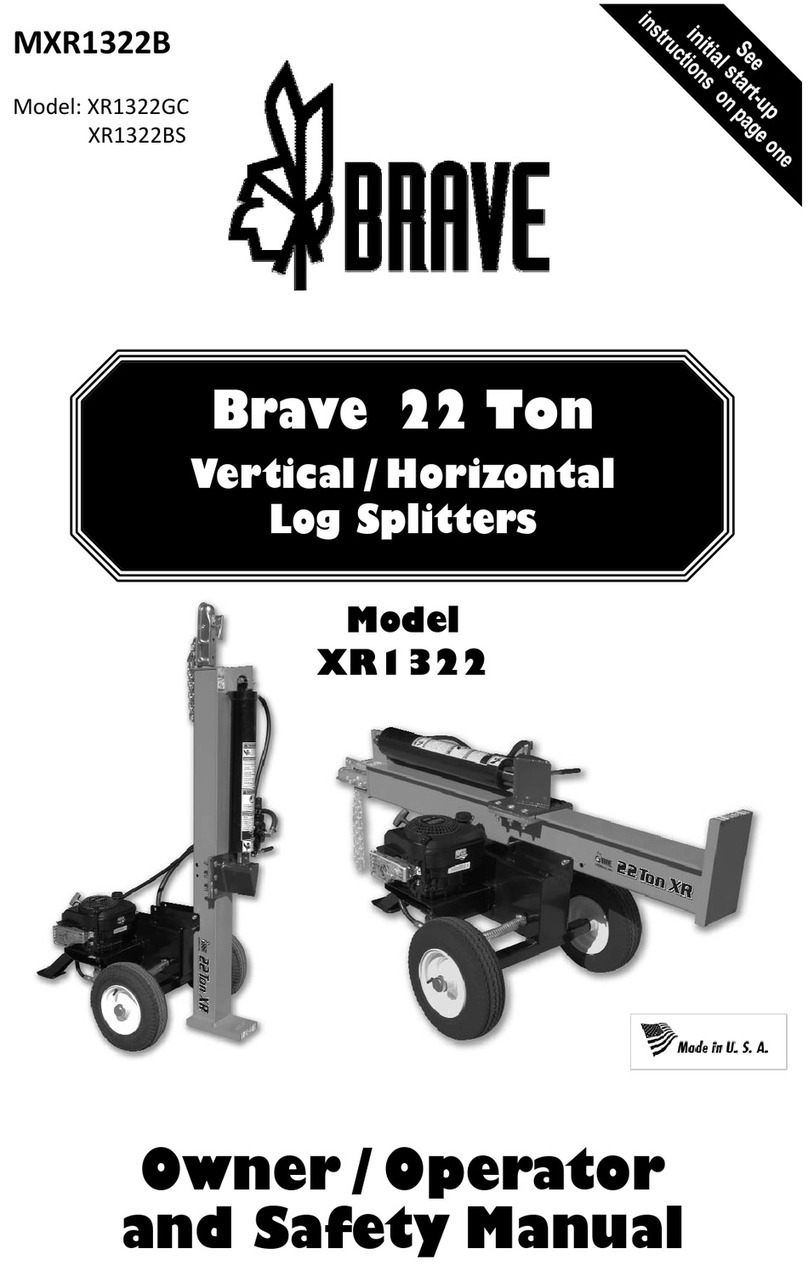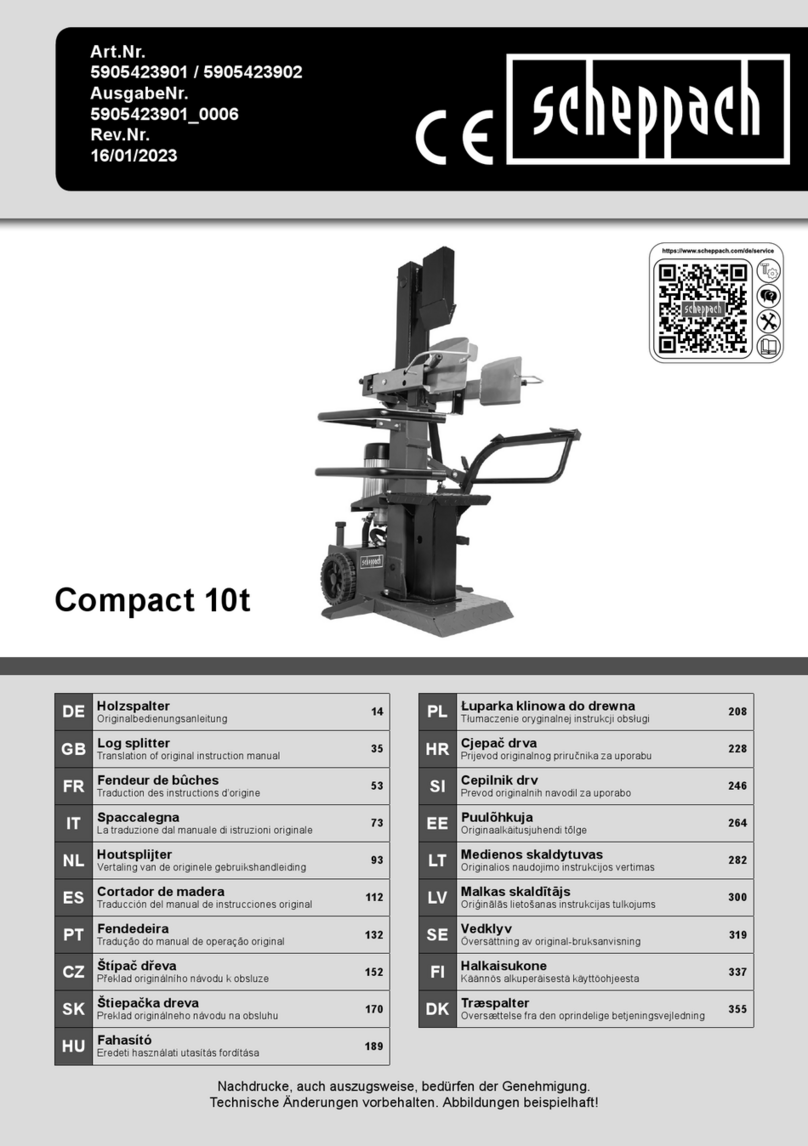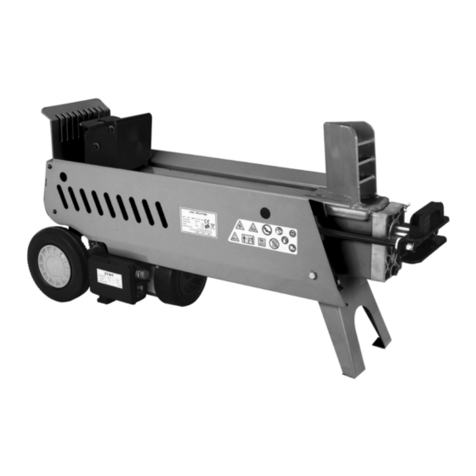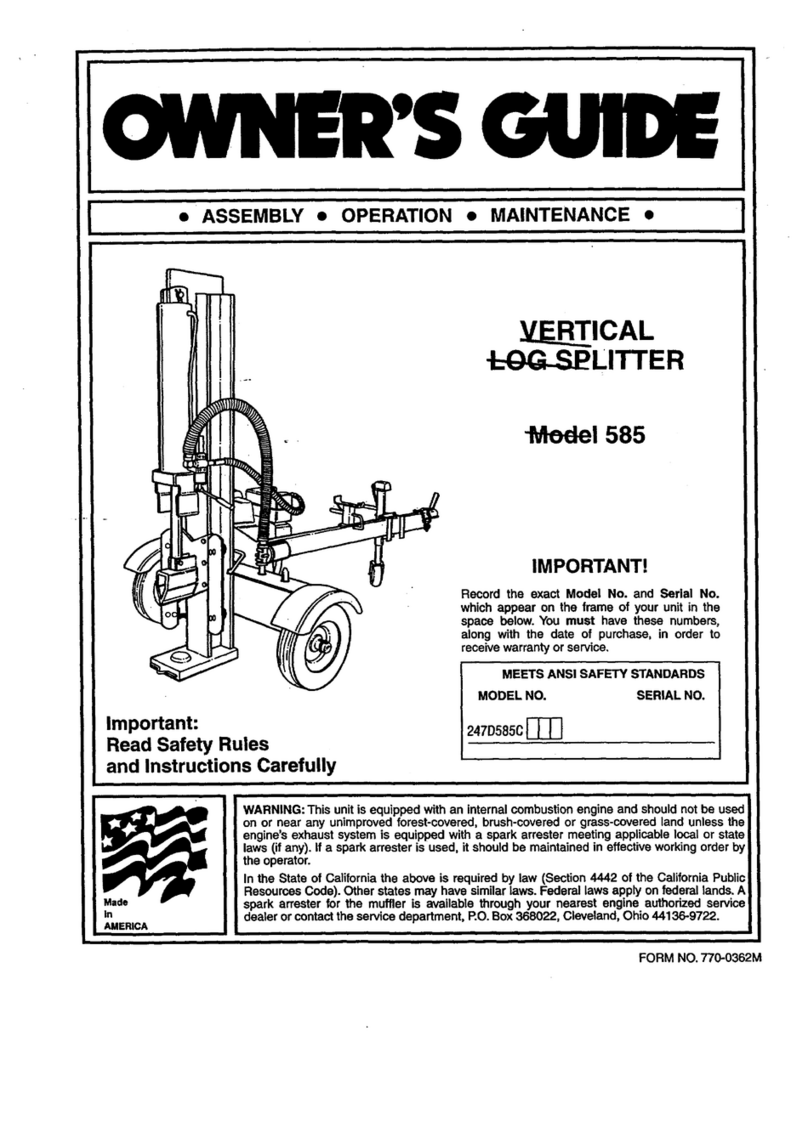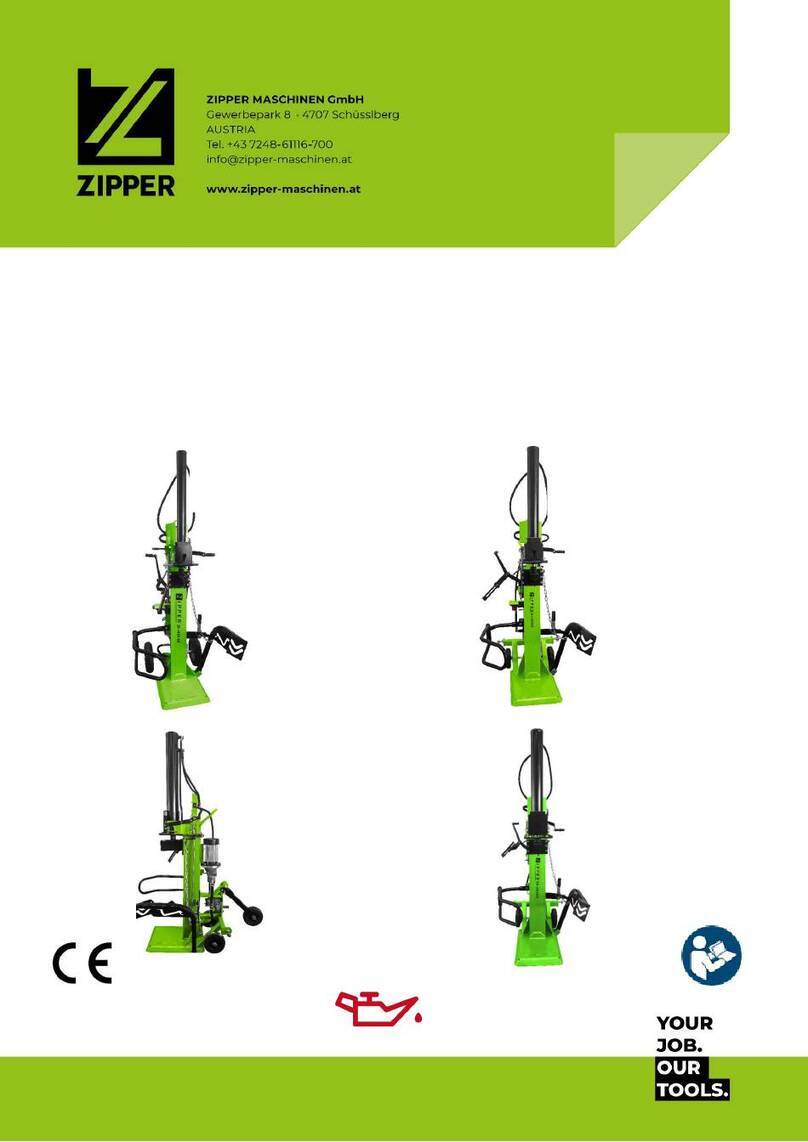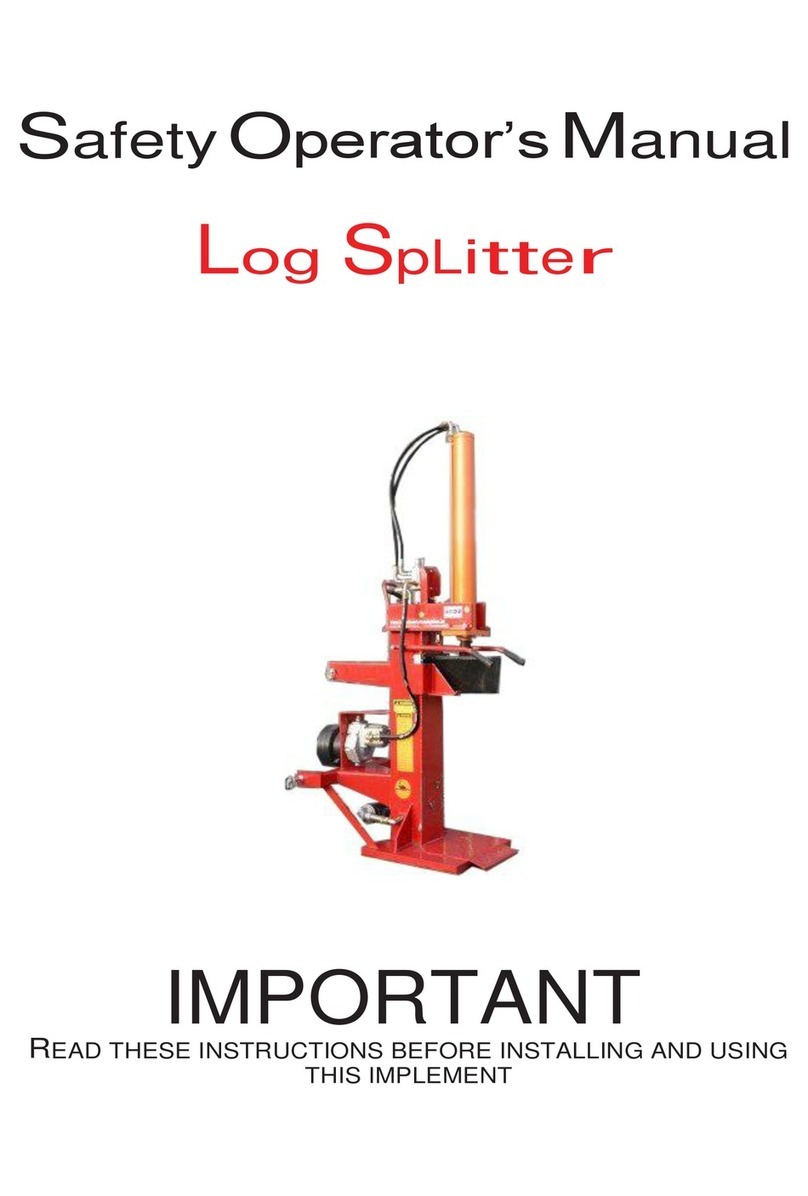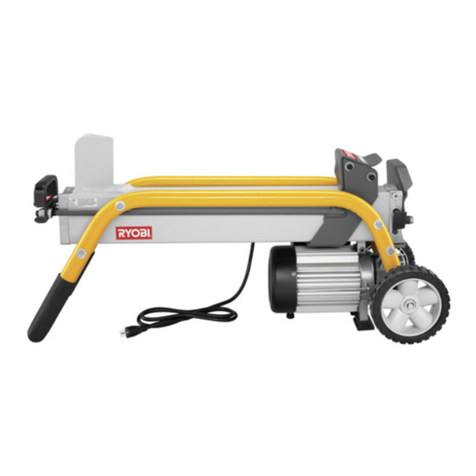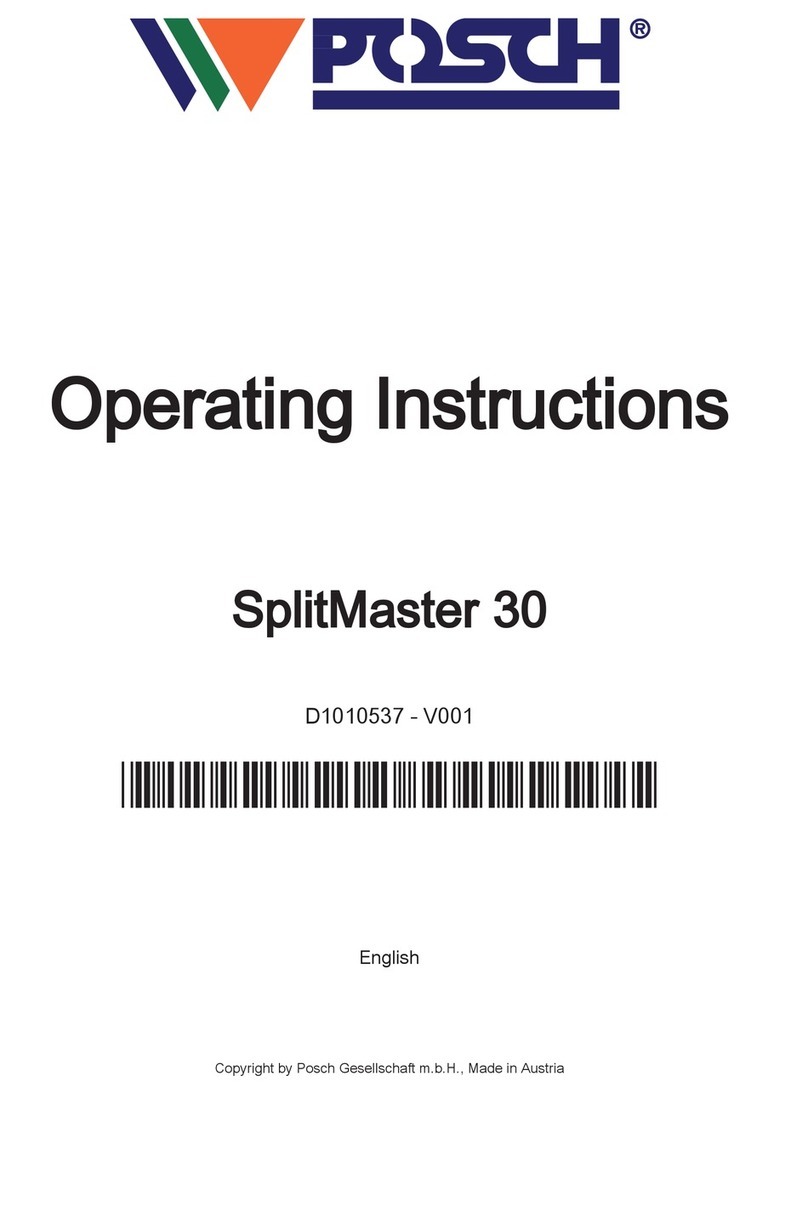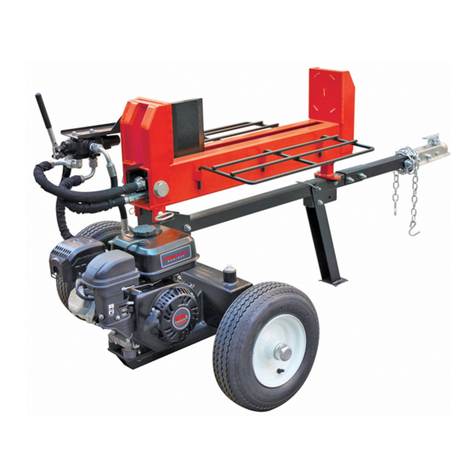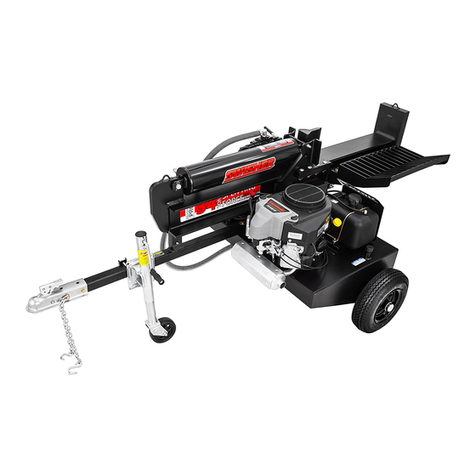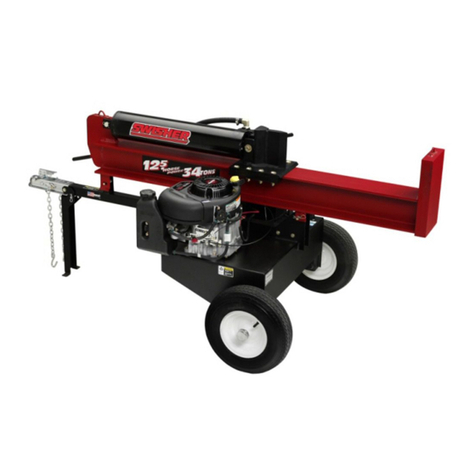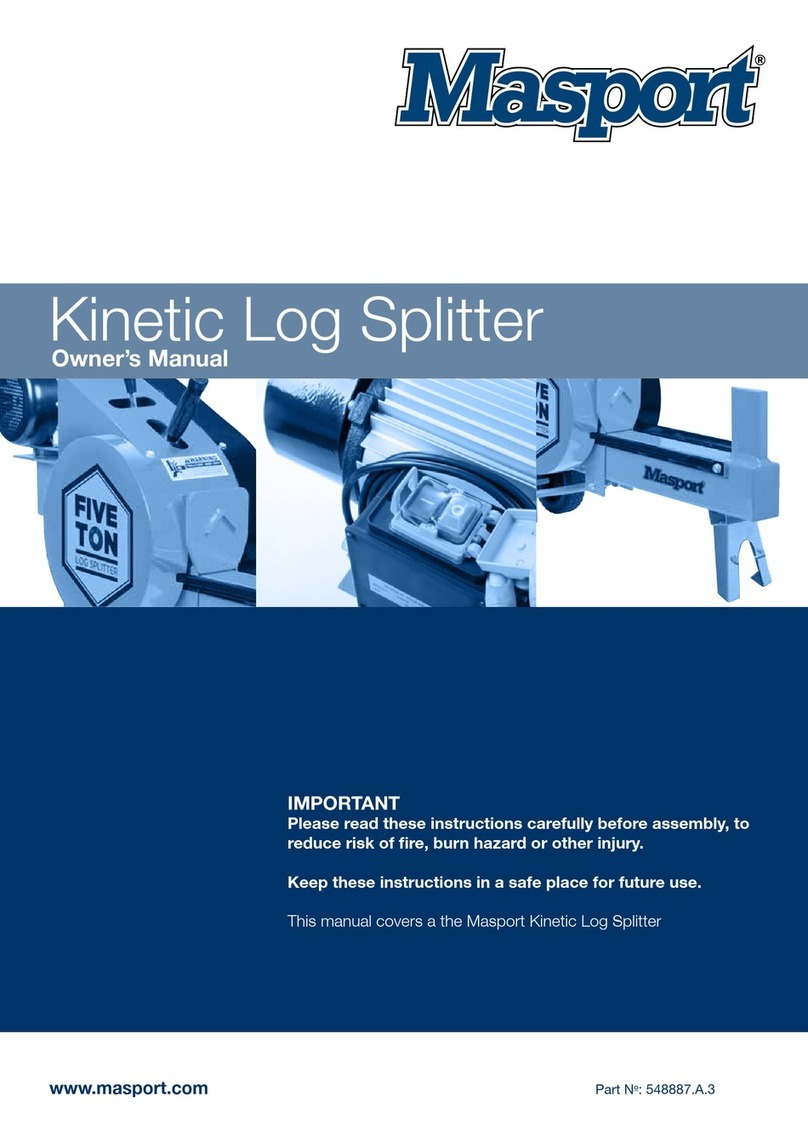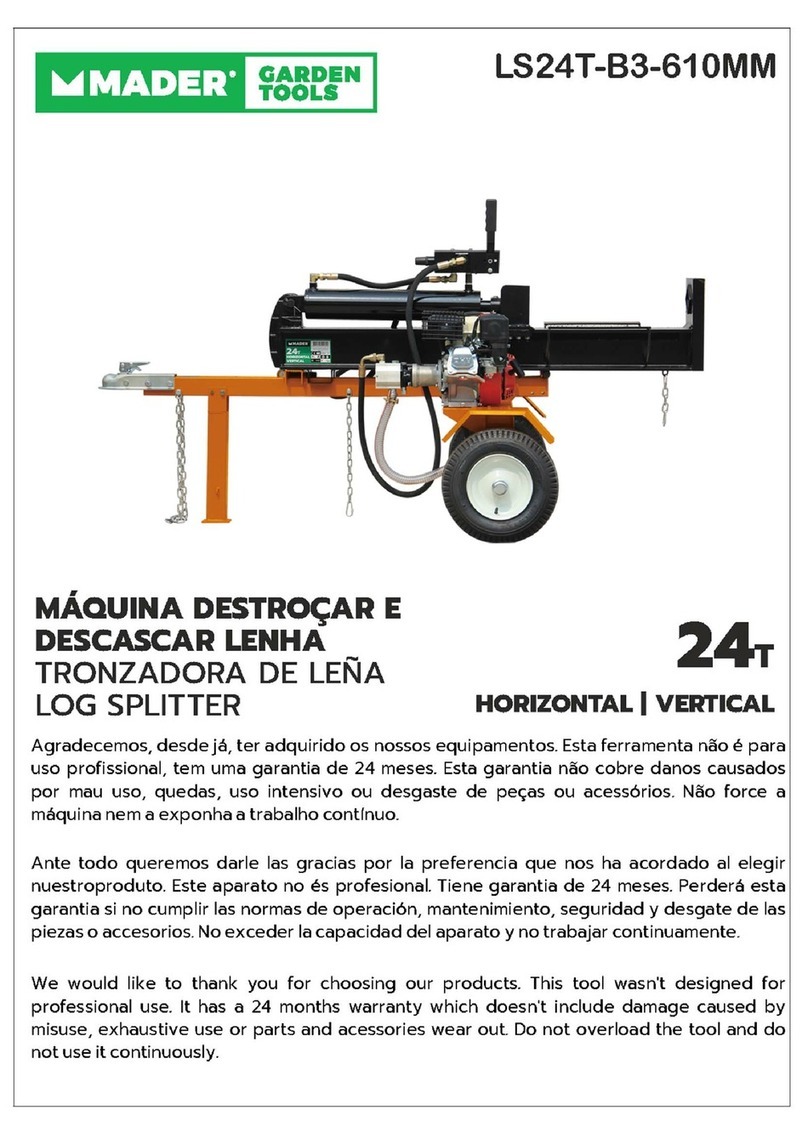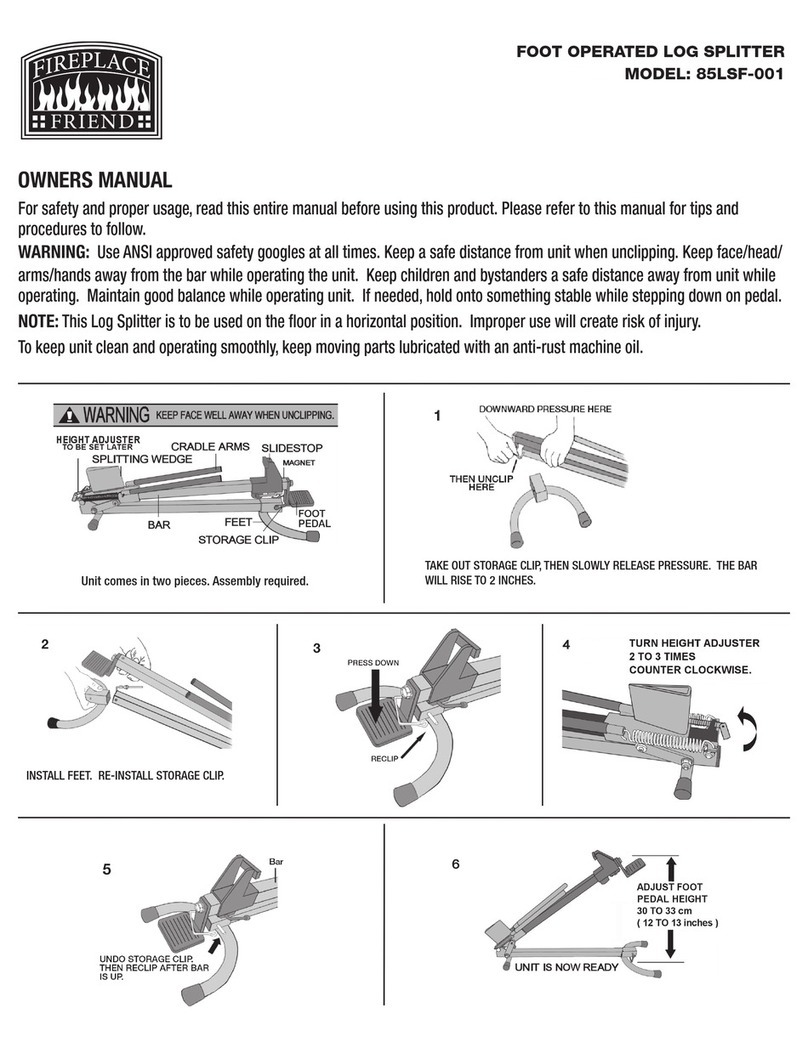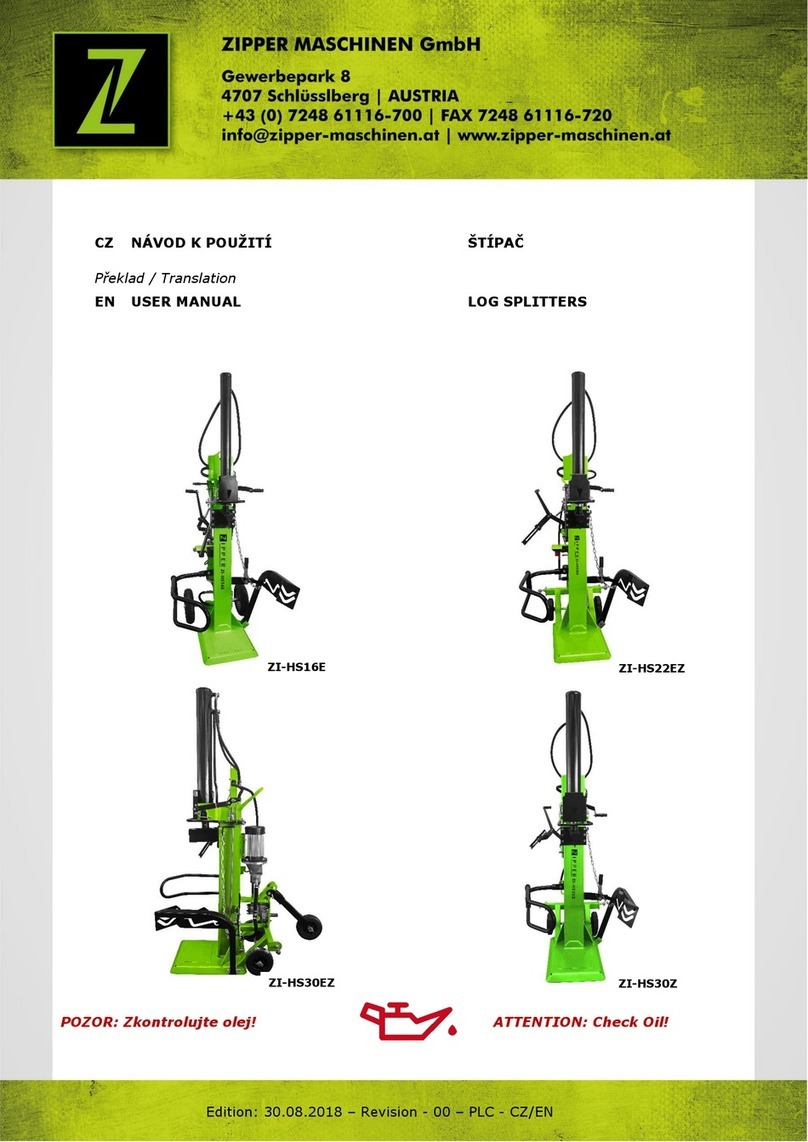Black Diamond Equipment BD201258 User manual

OPERATOR'S MANUAL
MODEL #BD201258
38 TON FULL BEAM LOG SPLITTER
READ AND SAVE THIS MANUAL. This manual contains important safety precautions which should be read and understood before operating the product. Failure to
do so could result in serious injury. This manual should remain with the product.
Specifications, descriptions and illustrations in this manual are as accurate as known at the time of publication, but are subject to change without notice.
4024-M-OP REV 20230113 EN Mid-States Distributing, LLC., Fort Worth, TX 76137 USA
or visit black-diamond.com
1-888-376-7375

2
TABLE OF CONTENTS
Introduction...................................................3
Safety Definitions ..........................................3
Important Safety Instructions.......................4
Fuel Safety .........................................................6
Training Instructions ...............................................7
Preparation .........................................................7
Operation ...........................................................8
Maintenance........................................................8
Safety and Dataplate Labels.......................................9
Safety Symbols................................................... 10
Controls and Features ................................. 12
Log Splitter ....................................................... 12
Parts Included .................................................... 13
Assembly ..................................................... 14
Open Shipping Crate ............................................. 14
1) Install the Wheels ............................................. 14
2) Install the Tow Bar ............................................ 14
3) Install the Beam ............................................... 14
4) Install the Engine .............................................. 15
5) Install the Hoses............................................... 15
6) Install the Log Catchers....................................... 16
Add Engine Oil.................................................... 17
Add Fuel .......................................................... 17
Add Hydraulic Oil ................................................. 17
Operation..................................................... 18
Before Each Use Inspect the Log Splitter ....................... 18
Changing Beam from Horizontal to Vertical Orientation ........ 18
Towing Log Splitter Safety....................................... 19
Log Splitter Location............................................. 19
Starting the Engine............................................... 19
Stopping the Engine.............................................. 20
Log Splitter Operation............................................ 20
Operation at High Altitude ....................................... 20
Maintenance ................................................21
Cleaning the Log splitter......................................... 21
Changing the Engine Oil ......................................... 21
Cleaning and Adjusting the Spark Plug(s) ....................... 21
Cleaning the Air Filter ............................................ 21
Changing the Hydraulic Oil....................................... 21
Maintenance Schedule........................................... 22
Storage ........................................................24
Log Splitter Storage.............................................. 24
Engine Storage ................................................... 24
Specifications..............................................25
Log Splitter Specifications....................................... 25
Hydraulic Oil System ............................................. 25
Engine Specifications ............................................ 25
Oil Specifications................................................. 25
Fuel Specifications ............................................... 25
Important Message About Temperature......................... 25
Troubleshooting...........................................26
Warranty......................................................27
Warranty Qualifications .......................................... 27
Repair/Replacement Warranty................................... 27
Do Not Return The Unit To The Place Of Purchase ............. 27
Warranty Exclusions ............................................. 27
Other Exclusions ................................................. 27
Limits of Implied Warranty and Consequential Damage........ 27
Contact Information .............................................. 27
FOR PARTS BREAKDOWN
Search by model number at
championpowerequipment.com

3
INTRODUCTION
Congratulations on your purchase of a Black Diamond product.
Black Diamond designs, builds, and supports all of our products
to strict specifications and guidelines. With proper product
knowledge, safe use, and regular maintenance, this product
should bring years of satisfying service.
Every effort has been made to ensure the accuracy and
completeness of the information in this manual at the time of
publication, and we reserve the right to change, alter and/or
improve the product and this document at any time without prior
notice.
Black Diamond highly values how our products are designed,
manufactured, operated, and serviced as well as providing safety
to the operator and those around the log splitter. Therefore, it
is IMPORTANT to review this product manual and other product
materials thoroughly and be fully aware and knowledgeable of
the assembly, operation, dangers and maintenance of the product
before use. Fully familiarize yourself, and make sure others who
plan on operating the product fully familiarize themselves too,
with the proper safety and operation procedures before each use.
Please always exercise common sense and always err on the
side of caution when operating the product to ensure no accident,
property damage, or injury occurs. We want you to continue to
use and be satisfied with your Black Diamond product for years to
come.
When contacting Black Diamond/Champion Power Equipment
about parts and/or service, you will need to supply the complete
model and serial numbers of your product. Transcribe the
information found on your product’s dataplate label to the table
below.
BLACK DIAMOND TECHNICAL SUPPORT TEAM
1-888-376-7375
MODEL NUMBER
BD201258
SERIAL NUMBER
DATE OF PURCHASE
PURCHASE LOCATION
SAFETY DEFINITIONS
The purpose of safety symbols is to attract your attention to
possible dangers. The safety symbols, and their explanations,
deserve your careful attention and understanding. The safety
warnings do not by themselves eliminate any danger.
The instructions or warnings they give are not substitutes for
proper accident prevention measures.
DANGER
DANGER indicates a hazardous situation which, if not avoided,
will result in death or serious injury.
WARNING
WARNING indicates a hazardous situation which, if not
avoided, could result in death or serious injury.
CAUTION
CAUTION indicates a hazardous situation which, if not avoided,
could result in minor or moderate injury.
NOTICE
NOTICE indicates information considered important, but not
hazard-related (e.g., messages relating to property damage).

4
IMPORTANT SAFETY INSTRUCTIONS
WARNING
Cancer and Reproductive Harm – www.P65Warnings.ca.gov
DANGER
Engine exhaust contains carbon monoxide, a colorless,
odorless, poison gas. Breathing carbon monoxide will cause
nausea, dizziness, fainting or death.
If you start to feel dizzy or weak, move to fresh air immediately.
Operate log splitter outdoors only in a well ventilated
area.
DO NOT operate the log splitter inside any building, including
garages, basements, crawlspaces, sheds, or enclosure.
DO NOT allow exhaust fumes to enter a confined area through
windows, doors, vents or other openings.
DANGER
Using an engine indoors CAN KILL YOU IN MINUTES. Engine
exhaust contains carbon monoxide. This is a poison you cannot
see or smell.
NEVER use inside a home or garage, EVEN IF doors and
windows are open.
ONLY use OUTSIDE and far away from windows, doors,
and vents.
WARNING
Although the log splitter contains a spark arrester, maintain
a minimum distance of 5 ft. (1.5 m) from dry vegetation to
prevent fires.
WARNING
Sparks can result in fire or electrical shock.
When servicing the engine:
Disconnect the spark plug wire and place it where it cannot
contact the plug.
DO NOT check for spark with the plug removed.
Use only approved spark plug testers.
WARNING
Running engines produce heat. Severe burns can occur on
contact. Combustible material can catch fire on contact.
DO NOT touch hot surfaces.
Avoid contact with hot exhaust gases.
Allow equipment to cool before touching.
Maintain at least 3 ft. (91.4 cm) of clearance on all sides to
ensure adequate cooling.
WARNING
Crush Hazard
Wedge can cut through skin and break bones. Keep all limbs
away from wedge and endplate.
WARNING
Projectile Hazard
Pieces of log may be ejected from the splitter while operating.
Always wear ANSI approved safety glasses when operating.
Be alert.
WARNING
Keep operator work zone clear of debris while working to
ensure safe footing.
DANGER
Skin Injection Hazard.
Hydraulic oil escaping under high pressure can penetrate skin
and cause serious bodily injury. In the event that hydraulic oil
may penetrate the skin and to avoid serious infections such as
gangrene, seek proper medical attention immediately.
WARNING
Always make sure all hydraulic oil connections are tightly
secured and hydraulic hoses are in good condition, no cuts,
tears, or damage before applying pressure to the system.

5
IMPORTANT SAFETY INSTRUCTIONS
WARNING
Always keep hands and body parts away from nozzles or
pinholes that could eject hydraulic oil under high pressure in
the event of an oil leak.
NEVER use bare hands to search for leaks. Leaks can be
detected by using cardboard, paper or scrap wood over the
suspected area.
WARNING
Towing Hazard
Always check with your local municipality, state or provincial
regulations regarding towing, lights and licensing before
towing your log splitter on public roads.
BEFORE towing, review all safety warnings in your towing
vehicle manual. Drive safely. Be aware of the added length of
the log splitter.
NEVER ride or transport cargo on the log splitter.
DO NOT exceed the maximum 45 MPH (72 KM/H) towing
speed.
WARNING
Before removing the pin installed on the front support leg,
make sure the hitch is installed onto the vehicle. Releasing
the pin before will cause support leg to slide up and possibly
cause injury.
WARNING
Rapid retraction of the starter cord will pull hand and arm
towards the engine faster than you can let go. Broken bones,
fractures, bruises or sprains could result.
When starting engine, pull the starter cord slowly until
resistance is felt and then pull rapidly to avoid kickback.
CAUTION
Parts of the hydraulic circuit (cylinder, pump, valve-body,
hoses) can become very hot during operation.
WARNING
Improper treatment or use of the log splitter can damage it,
shorten its life and void your warranty.
ALWAYS use the log splitter for its intended use.
Operate only on level surfaces.
DO NOT expose log splitter to excessive moisture, dust,
or dirt.
DO NOT allow any material to block the cooling slots.
DO NOT use the engine if:
–Equipment sparks, smokes or emits flames
–Equipment vibrates excessively

6
IMPORTANT SAFETY INSTRUCTIONS
Fuel Safety
DANGER
GASOLINE AND GASOLINE VAPORS ARE HIGHLY
FLAMMABLE AND EXPLOSIVE.
Fire or explosion can cause severe burns or death.
Gasoline and gasoline vapors:
–Gasoline vapors are highly flammable and explosive.
–Gasoline vapors can cause a fire or explosion if ignited.
–Gasoline is a liquid fuel and the resulting gasoline vapors can
ignite and cause a fire or explosion.
–Gasoline is a skin irritant and needs to be cleaned up
immediately if spilled on skin or clothes.
–Gasoline has a distinctive odor, this will help detect potential
leaks quickly.
–In any petroleum gas fire, flames should not be extinguished
unless by doing so the fuel supply valve can be turned OFF.
This is because if a fire is extinguished and a supply of fuel is
not turned OFF, then an explosion hazard could be created.
–Gasoline vapors expand and contract with ambient
temperatures. Never fill the gasoline tank past the red FULL
indicator on the fuel filter, as gasoline vapors needs room to
expand if temperatures rise.
WARNING
When adding or removing gasoline:
Do not light or smoke cigarettes.
Always stop the engine and allow to cool for a minimum of two
minutes before refueling.
Always loosen gasoline cap slowly to release vapor pressure
and to keep fuel from escaping around the gasoline cap.
Always replace and tighten the gasoline cap securely after
fueling.
Never remove the gasoline cap or add gasoline while the
engine is running or when the engine is hot.
Only fill or drain gasoline outdoors in a well-ventilated area.
Do not pump gasoline directly into the log splitter at the gas
station.
Always store gasoline in an EPA/CARB compliant container or
to transfer the gasoline to the log splitter.
Do not overfill the gasoline tank.
Always keep gasoline away from sparks, open flames, pilot
lights, heat and other sources of ignition.
WARNING
When starting the log splitter:
Do not attempt to start a damaged log splitter.
Always check that the gasoline cap, air filter, spark plug, fuel
lines and exhaust system are properly in place.
Always allow spilled gasoline to evaporate fully before
attempting to start the engine.
Always be certain that the log splitter is resting firmly on level
ground.
WARNING
When operating the log splitter:
Do not move or tip the log splitter during operation.
WARNING
When transporting or servicing the log splitter:
Always check that the fuel valve is in the OFF position and the
gasoline tank is empty.
Disconnect the spark plug wire.
WARNING
When storing the log splitter:
Store away from sparks, open flames, pilot lights, heat and
other sources of ignition.
Do not store log splitter or gasoline near furnaces, water
heaters, or any other appliances that produce heat or have
automatic ignitions.
DANGER
Never place a gasoline container, gasoline tank, or any
combustible material in the path of the exhaust stream during
operation of the engine.
WARNING
Never use a gasoline container, gasoline tank, or any other fuel
item that is broken, cut, torn or damaged.

7
IMPORTANT SAFETY INSTRUCTIONS
Training Instructions
CAUTION
1. Read the Operator’s Manual completely before attempting
to use this log splitter.
2. Do not allow anyone to operate your log splitter who has
not read the Operator’s Manual or has not been instructed
on the safe use of the log splitter.
3. Never allow children or untrained adults to operate this
machine.
4. Accidents occur when more than one (1) person operates
the log splitter. If a helper is assisting in loading logs to
be split, never actuate controls until helper is clear of the
area.
5. Never transport cargo on the log splitter or ride on the
machine.
6. High fluid pressures develop in hydraulic log splitters.
Pressurized hydraulic fluid escaping through a pin hole
opening can puncture skin and cause severe infections or
blood poisoning. Therefore, these instructions should be
followed at all times.
–Do not operate the unit with frayed, kinked, cracked
or damaged hoses, fittings, or tubing.
–Stop the engine and relieve hydraulic system pressure
before changing or adjusting fittings, hoses, tubing, or
other system components.
–Do not adjust the pressure settings of the pump or
valve.
–Do not check for leaks with your hand. Leaks can
be detected by passing cardboard or wood over the
suspected area. Look for discoloration. If injured by
escaping fluid, see a doctor at once. Serious infection
or reaction can develop if proper medical treatment is
not administered immediately.
7. Keep the operator zone and adjacent area clear for safe,
secure footing.
8. Your log splitter is equipped with an internal-combustion
engine and is not intended for use near any unapproved
regulated and controlled forest, brush, or grass covered
land. Always check with your local municipality, state and
federal regulations prior to use.
9. Log splitters should be used only for splitting wood.
Preparation
CAUTION
1. Be thoroughly familiar with all controls and with proper
use of the equipment.
2. Safety Gear:
–Always wear safety shoes or heavy boots when
operating the machine.
–Always wear safety glasses or goggles when
operating the machine.
–Never wear jewelry or loose-fitting clothing that might
become entangled in moving or rotating parts of the
machine.
3. Make sure the splitter is on a level surface. Block tires
and ensure support leg is secure to prevent unintended
movement of the log splitter during operation.
–Always operate the splitter from the manufacturer’s
indicated operator zone.
4. Logs to be split on ram-type units should be cut as
squarely as possible.

8
IMPORTANT SAFETY INSTRUCTIONS
Operation
CAUTION
1. Before starting this log splitter, review all safety
instructions. Failure to follow these instructions may
result in serious injury to the operator or bystanders.
2. Be sure to confirm all hose clamp connections are tight
before each use. It is possible for clamp connections to
vibrate loose over time.
3. Never leave the machine unattended with the power
source operating.
4. Never operate the machine when under the influence of
alcohol, drugs or medication.
5. The machine owner should instruct all operators in safe
log splitter operation.
6. Always operate the log splitter with all safety equipment
in place and all controls properly adjusted for safe
operation.
7. Always operate the log splitter at manufacturer’s
recommended speed.
8. Always keep hands and feet clear of moving parts.
9. When loading a ram-type log splitter, place your hands on
the sides of the log, not the ends. Never place your hands
or any part of your body between a log and any part of the
log splitter.
10. On ram-type log splitters, never attempt to split more
than one (1) log at a time unless the ram has been fully
extended and a second log is needed to complete the
separation of the first log.
11. On ram-type log splitters on which the logs are not cut
square, the longest portion of the log should be rotated
down and the most square end placed against the ram.
12. Always split logs with the grain of the wood.
13. Never split perpendicular to the grain of the wood.
14. Use only your hand to operate the log splitter controls.
15. Never add fuel to a running or hot engine.
16. Always turn the engine off and wait a minimum of 2
minutes to cool engine before removing gasoline cap prior
to refueling.
Maintenance
CAUTION
1. Always shut off the power source while repairing or
adjusting the splitter except as recommended by the
manufacturer.
2. Clean debris and chaff from the engine cylinder, cylinder
head fins, recoil starter cover, and muffler areas. The
engine is equipped with a spark arrestor muffler, clean
and inspect it regularly (follow manufacturer’s service
instructions). Replace, if damaged.
3. Check to be sure all nuts and bolts are tight to assure
the equipment is in safe working condition before next
operation.

9
IMPORTANT SAFETY INSTRUCTIONS
Top Back
A
Safety and Dataplate Labels
These labels warn you of potential hazards that can cause serious injury. Read them carefully.
If a label comes off or becomes hard to read, contact Technical Support Team for possible replacement.
LABEL DESCRIPTION
A
1117-L-SF-B
DANGER PELIGRO WARNING ADVERTENCIA AVERTISSEMENTDANGER
HORIZONTAL WORK ZONE
AREA DE TRABAJO HORIZONTAL
ZONE DE TRAVAIL HORIZONTALE
K485 2945 109 30%K
ColorsLPN 1117-L-S F
Rev A
Size 190 x 44 mm
Artwork Notes
3mm corner radius; 2mm safe margin
Revision Changes
-Adde d safe work zo ne
This ar twork belongs to C hampion Power Equi pment. The conte nts are confiden tial and privileg ed and shall not be disc losed to or used by or f or
outside p arties withou t the explicit conse nt of Champion Power E quipment.
VERTICAL WORK ZONE
AREA DE TRABAJO VERTICAL
ZONE DE TRAVAIL VERTICALE
Safety Symbols
B
MID-STATES DISTRIBUTING, LLC.
FORT WORTH, TX 76137
USA / É.-U.
1-888-376-7375
MADE IN CHINA / FABRIQUÉ EN CHINE
4000-L-PR
MANUFACTURE DATE
DATE DE FABRICATION
SERIAL NO.
N° DE SÉRIE
MODEL
MODÈLE BD201258
XXXX
XXXXXXXXXXXX
K--- --- --- ---
ColorsLPN 4000-L-PR
Rev A
Size 51 x 64 mm
Artwork Notes
3mm corner radius; 2 mm safe margin; to be prin ted
on sec urity substrate; magenta text to be filled in
during time of production
Revision Changes
---
This ar twork belongs to Champion Power Equipment. The contents are confidential and privileged and shall not be disclosed to or used by or for
outside parties without the explicit consent of Champion Power Equipment.
Dataplate
B

10
IMPORTANT SAFETY INSTRUCTIONS
Safety Symbols
Some of the following symbols may be used on this product. Please study them and learn their meaning. Proper interpretation of these
symbols will allow you to more safely operate the product.
SYMBOL MEANING
Read Operator’s Manual. To reduce the risk of injury, user must read and understand operator’s
manual before using this product.
Eye and Ear Protection. Always wear safety goggles or safety glasses with side shields, and as
necessary a full face-shield as well as full ear protection when operating this product.
Footwear. Always wear safety shoes or heavy boots when operating the machine.
Gloves. Always wear nonslip, heavy-duty protective gloves when operating this product.
Safety Alert. Precautions that involve your safety.
Risk of Fire. Fuel and its vapors are extremely flammable and explosive. Fire can cause severe
burns or death. Do not add fuel while the product is operating or still hot.
Skin Injection Hazard. High pressure hydraulic oil can inject under your skin.
Make sure all fittings are tightly secure before applying pressure. Relieve system
pressure before servicing.
Always keep hands away from the wedge and the ram. Moving parts can crush or cut.

11
IMPORTANT SAFETY INSTRUCTIONS
SYMBOL MEANING
Always keep feet away from the wedge and the ram. Moving parts can crush or cut.
Hot Surface. To reduce the risk of injury or damage, avoid contact with any hot surface
Open Flame alert. Fuel and its vapors are extremely flammable and explosive. Keep fuel away
from smoking, open flames, sparks, pilot lights, heat, and other ignition sources.
Hold logs on sides when loading. Keep hands and feet away from cylinder, wedge,
and partially split logs.
Never place hands or any part of the body between a log and any part of the log splitter.
Do not split logs against the grain. Split logs end to end in the direction of the grain only.
Toxic Fumes. The engine exhaust from this product contains chemicals known to the state of
California to cause cancer and birth defects and other reproductive harm.
Risk of Asphyxiation. This engine emits carbon monoxide, an odorless, colorless poison gas.
Breathing carbon monoxide can cause nausea, fainting or death. Use only in a well ventilated
area.
Clearance. Keep all objects including others at least 10 feet (3m) from this machine.
Only one person should operate the log splitter and load the logs
Never operate on an incline. Make sure the splitter is on a level surface. Block tires and ensure
support leg is secure to prevent unintended movement of the log splitter during operation.
MAX. 45 MPH (72 km/h)
DO NOT exceed the maximum 45 MPH (72 KM/H) towing speed.
Always check all local, state or provincial regulations regarding towing, licensing and lights before
towing your log splitter. Review towing safety warnings in your towing vehicle manual.
In most states towing on public streets is either prohibited or would require further licensing or
modifications. Please check with your local, state, or provincial authorities regarding regulations,
restrictions and registration.
Any modifications required to meet these laws are the responsibility of the purchaser.

12
CONTROLS AND FEATURES
Read this operator’s manual before operating your log splitter. Familiarize yourself with the location and function of the controls and
features. Save this manual for future reference.
Log Splitter
1. Auto-Lock Horizontal Beam Lock – Secures the beam in
the horizontal position.
2. Hydraulic Cylinder – 5 in. bore (12.7 cm) × 23 in.
(58.4 cm) stroke. MAX to 3900 psi.
3. Control Valve Handle – Controls the movement of the
cutting wedge.
4. Wedge
5. Log Cradle – Prevents logs from rolling off beam.
6. Log Catchers
7. Quick-Lock Vertical Beam Lock – Secures the beam in the
vertical position.
8. Tires – Maximum travel speed is 45 MPH (72 KM/H).
9. Engine – 270cc, OHV.
10. Support Leg – Supports log splitter while operating. Raise
leg for towing.
11. Safety Chains – For use while towing.
12. 2 in. (5.1 cm) Ball Coupler – For towing the log splitter
behind your vehicle.
3
2
12
11
6
10
98
4
5
7
1

13
CONTROLS AND FEATURES
Parts Included
Part Part Qty. Hardware Needed Hardware
Qty. Tool Needed
Wheels 2
Castle Nut 21x 30mm open-end wrench
Cotter Pin Ø4 × 32 2Needle nose pliers
Axle Cap 2Mallet
Tow Bar 1
Bolt M12x80 21x 18mm wrench or socket
Nut M12 21x 19mm wrench or socket
Flat Washer Ø12 2
Beam 1Hitch Pin 1
R-Pin 1
Engine 1
Bolt M10x45 41x 16mm wrench
Lock Nut M10 41x 17mm wrench
Flat Washer Ø10 4
Suction Hose 1Spring Loaded Hose Clamp 2Clamp Tool
High Pressure Hose 1"O" Ring Ø10 x 2.65 11x 27mm open-end wrench
Oil Return Hose 11x 27mm open-end wrench
Log Catchers 2
Bolt M10x20 41x 16mm wrench or socket
Bolt M10x30 21x 6mm allen wrench
Nut M10 21x 17mm wrench
Lock Washer Ø10 6
Flat Washer Ø10 6
Accessories
–Spark Plug Wrench
–Oil Funnel

14
ASSEMBLY
If your log splitter is already assembled, skip the assembly
instructions in this manual.
If unassembled, please read and follow these instructions.
If you have any questions regarding the assembly of your log
splitter, call our Technical Support Team at 1-888-376-7375.
Please have your serial number and model number available.
Open Shipping Crate
1. Set the shipping crate on a solid, flat surface
2. Carefully cut the shipping bands and remove lid of shipping
crate.
3. Locate all hardware before beginning assembly.
1) Install the Wheels
1. Remove the two plastic shipping caps from the wheel hubs.
2. Slide the wheel onto the axle.
3. Be sure the tire valve stem is facing out.
4. Thread the castle nut on the axle and tighten by hand. Use a
wrench to tighten another ¼ turn.
5. Spin the wheel to distribute the bearing grease.
6. Loosen the castle nut and re-tighten by hand.
7. Install the cotter pin through the axle and castle nut.
8. Wheel should spin freely but when grasped on both sides,
should not move from side to side.
9. Install the axle cap using a soft-faced mallet or hammer and
wood block.
10. Repeat for the other wheel.
NOTICE
Keep dirt and debris away from the wheel bearings during
assembly.
CAUTION
Over-tightening the castle nut will cause the bearings to run
hot and fail prematurely.
2) Install the Tow Bar
Attach the tow bar to the bracket on top of the hydraulic oil tank
with two M12 × 80 bolts, Ø12 flat washers and M12 lock nuts.
3) Install the Beam
1. Stand the beam vertical on the foot plate.
2. Roll the tank into position so the pivot holes of the tank and
beam are aligned.
3. Insert the Pin and secure it with the R-pin.
WARNING
The beam is extremely heavy and should only be handled
with 2 or more people. DO NOT try and lift or handle the beam
without assistance.

15
ASSEMBLY
4) Install the Engine
1. Place the engine on the engine mounting platform with the
recoil cover facing outward towards the wheel and align
the 4 holes on the engine base with the holes in the engine
platform.
2. Install a M10 × 45 bolt up through the hole on the engine
platform and through the hole on the engine base.
3. Place a washer on the M10 × 45 bolt and thread a M10 nylon
lock nut onto the bolt and tighten securely. Tighten to
12 lbf-ft – 15 lbf-ft (16-20 Nm) or fully, then a 1/4 turn further.
4. Repeat steps 2 and 3 for the remaining bolts, washers and
lock nuts.
5) Install the Hoses
CAUTION
Red shipping plugs must be removed from hydraulic pump
prior to installing hoses.
Hydraulic pump may contain
residual oil from
testing procedures
during production.
We recommend using an oil
tray under the pump before
removing the shipping plugs.
NOTICE
Oil Inlet (High Pressure) and Oil Return Hoses
Some hoses may be preassembled by the factory, check your
hoses per below instructions to ensure proper assembly.
–These hoses are black and have swivel nuts on both ends.
–The Oil Inlet Hose sends hydraulic oil from the pump to the
control valve/cylinder.
–The Oil Return Hose returns hydraulic oil from the control
valve/cylinder to the tank.
–Hose connections do NOT require thread seal tape. The
O-ring seals against the face of the fittings on the pump
and hose.
Suction Hose
–This is the clear hose that connects the hydraulic tank to
the pump inlet.
–Secure both ends of hose with hose clamps.
Suction Hose
1. Using the provided spring loaded hose clamps, connect one
end of the clear oil hose to the hydraulic oil tank and the other
end to the pump inlet on the pump. Using a pair of pliers,
squeeze the tabs on the spring loaded hose clamps together
to open them up and slide over the end of the clear suction
hose and mounting fitting and release the pliers to lock the
clamps into place.

16
ASSEMBLY
Oil Inlet (High Pressure) Hose
2. Place the provided o-ring into the pump outlet fitting as
shown. Make sure the o-ring is properly seated in the inner
groove of the fitting.
3. Thread the loose end of the high pressure hydraulic hose onto
the pump outlet.
4. Securely tighten the hose fitting with a 27mm wrench.
Tighten to 44 lbf-ft - 52 lbf-ft (59.7-70.5 Nm).
Oil Return (Low Pressure) Hose
5. Thread the loose end of the low pressure hydraulic hose
onto the tapered hydraulic fitting on the hydraulic fluid tank.
This hose fitting will only fit on this fitting to ensure correct
connection.
6. Securely tighten the fitting with a 27mm wrench. Tighten to
52 lbf-ft - 66 lbf-ft (70.5-89.5 Nm). Make sure the fitting,
when fully tightened is angled upward as shown.
6) Install the Log Catchers
Large Log Catcher (Engine Side)
1. With the log catcher angled upward, align the four holes
on the log catcher with the 4 threaded holes on the splitter
beam.
2. Place a Ø10 flat washers and Ø10 lock washers onto the four
M10 × 20 bolts and thread them through the holes on the log
catcher and into the holes on the splitter beam and tighten
securely.
Small Log Catcher (Hydraulic Hose Side)
3. With the log catcher angled downward and under the lip of
the splitter beam, align the two holes on the log catcher with
the two holes on the beam lip.
4. Place the two M10 × 30 bolts through the holes on the beam
and through the holes on the log catcher. Place a Ø10 flat
washer and a Ø10 lock washer onto the bolt from the bottom
side and thread the M10 nuts onto the bolts and tighten
securely.
CORRECT
ASSEMBLY
ORIENTATION
INCORRECT
ASSEMBLY
ORIENTATION

17
ASSEMBLY
Add Engine Oil
Refer to Honda’s engine owner/operator manual.
Add Fuel
Refer to Honda’s engine owner/operator manual.
Add Hydraulic Oil
If your log splitter was delivered pre-assembled, follow these
instructions:
1. Position the log splitter on a flat, level surface.
2. Remove the plastic shipping plug from the oil tank on the top
of the tank (A) and discard. Replace with the steel oil plug
(with breather hole) shipped with your log splitter (A).
CAUTION
Do not run the log splitter with the temporary oil tank shipping
plug.
Pressure will build up inside the tank and potential damage
could occur.
3. After running and cycling the unit several minutes (purging air
from the system), turn off the engine and check the hydraulic
oil level using the oil sight glass. Oil level should visibly fill the
glass sight.
If your log splitter was delivered unassembled, follow these
instructions:
1. Make sure the log splitter is on a flat, level surface.
2. Remove the oil plug from the oil tank (A).
3. Add 5 gal (18.9 L) of hydraulic oil - see specification section
for types of acceptable oil.
4. Check the hydraulic oil level using the oil sight glass.
Oil level should visibly fill the sight glass.
A
WARNING
DO NOT remove the hydraulic oil fill cap when the engine
is running or hot. Hot oil can escape causing severe burns.
Always allow the log splitter to cool completely before
removing the hydraulic oil cap.
High fluid pressure and temperatures are created in the
hydraulic log splitters. Hydraulic fluid will escape through a
pin-size hole opening and can puncture skin and cause severe
blood poisoning.
Inspect hydraulic system regularly for possible leaks.
Never check for leaks with your hand while the system is
pressurized. Seek medical attention immediately if injured by
escaping fluid.
5. Replace and tighten the oil plug and orient the vent hole away
from the operator zone.
6. Start Engine. (See starting the engine section)
7. Extend and retract the wedge to purge air from the hydraulic
system. When the wedge motion is smooth,
the system is properly purged.
8. Check the hydraulic oil tank sight glass. Add approximately
1 gal. (3.8 L) of hydraulic oil to bring the level back up to the
sight glass. Do NOT overfill.
9. Check oil level daily and add as needed.
NOTICE
When the outdoor temperature is below 32˚F (0˚C), Dexron III
transmission fluid can be used. Do not mix hydraulic oil and
transmission fluid. Drain all oil or fluid before adding the other
one.
See hydraulic oil system specifications section for more
details.
NOTICE
To check oil level, place on level surface and use the oil sight
glass on the tank. The oil sight glass has a marker for the
acceptable level of oil. If oil is below the marker, add oil as
needed. DO NOT OVERFILL.

18
OPERATION
Before Each Use Inspect the Log Splitter
1. Check the hydraulic oil level and visually inspect all hoses,
attachments and cylinder for loose fittings, leaks, cracks,
fraying or other damage.
2. DO NOT operate the log splitter if there is any indication of
damage.
3. Inspect the engine and make sure the oil level is correct
before operating. If the engine is equipped with a spark
arrestor, clean and inspect it regularly (follow spark arrestor
maintenance schedule).
4. The tires need to be fully inflated and in good repair.
Reference the tire sidewall for recommended tire pressure.
WARNING
DO NOT over inflate tires. Serious injury can result if tires
explode.
DO NOT tow the log splitter if the tires are worn or will not hold
air.
DO NOT exceed the maximum 45 MPH (72 KM/H) towing
speed.
Changing Beam from Horizontal to Vertical
Orientation
When logs are too heavy to lift, log splitter beam can be moved
from horizontal to vertical orientation.
To change from horizontal to vertical orientation:
1. Block the wheels to prevent the unit from rolling.
2. Pull the spring loaded pin out on the horizontal beam lock
attached to the tow bar to release the beam. Standing
alongside the hydraulic ram, (opposite side from the engine)
firmly grasp the handle on the beam and lift upward while
pushing the beam back until upright. (Caution, beam is
heavy.)
3. Pull out the spring loaded quick-lock pin and rotate it around
to the 9 o’clock position around the lip on the beam to secure
it in the vertical position.
4. To change from vertical to horizontal orientation, reverse the
steps. The beam will automatically lock into the auto-lock on
the tow bar when lowered into position.

19
OPERATION
Towing Log Splitter Safety
1. Always check local, state or provincial regulations regarding
towing, licensing and lights before towing your log splitter.
Review towing safety warnings in your towing vehicle manual.
2. Before towing make sure the log splitter is correctly and
securely attached to the vehicle and the safety chains
attached with enough slack to allow for turning.
3. Support leg must be pinned in the “UP” position for towing.
4. Never exceed the max. travel speed of 45 mph (72 km/h).
Towing the log splitter at speeds greater than 45 mph
(72 km/h) could result in serious injury or death. Always
adjust your towing speed according to the terrain and
conditions.
5. Always disconnect the log splitter from the towing vehicle
before operating.
Log Splitter Location
This log splitter must have at least seven feet of clearance from
combustible material. Leave at least three feet of clearance on all
sides of the log splitter to allow for adequate cooling, maintenance
and servicing. DO NOT place the log splitter near vents or intakes
where engine exhaust fumes could be drawn into occupied or
confined spaces. ONLY operate the log splitter outdoors.
The log splitter needs to be on a dry level surface with good
footing. DO NOT work on mud, ice, tall grass, brush or snow.
Only operate log splitter from work zone shown below.
W
o
r
k
Z
o
n
e
HORIZONTAL OPERATING
POSITION
W
o
r
k
Z
o
n
e
VERTICAL OPERATING
POSITION
NOTICE
For Vertical Operation:
–Remove the beam lock-pin from the beam bracket
–Use handle on cylinder to rotate beam to vertical position.
–Insert beam lock-pin in the pivot bracket.
WARNING
ALWAYS use the log splitter for its intended use. The log
splitter should only be used to split wood logs, length wise
with the grain.
NEVER modify, alter or change the log splitter in anyway.
Modifications will void the warranty.
NEVER attach a rope, cable or other device to the control lever
on the log splitter.
DO NOT modify or change the engine and operating speeds or
pressure settings. These changes can cause safety issues.
ONLY operate the log splitter in daylight.
NEVER operate, or let anyone else operate the log splitter
while under the influence of alcohol, drugs, or medication.
NEVER leave the log splitter unattended while the engine is
running.
DO NOT change the splitting position with the engine running.
Contact with the muffler can cause serious burns.
ALWAYS make sure the beam is in the locked position.
DO NOT let the beam drop as it could crush fingers or cause
damage to the log splitter.
Starting the Engine
Refer to Honda’s engine owner/operator manual.
DANGER
Always operate log splitter outdoors and far away from
building, windows, doors and intake ventilation covers.

20
OPERATION
Stopping the Engine
Refer to Honda’s engine owner/operator manual.
Log Splitter Operation
1. ALWAYS wear ear and eye protection, protective clothing and
safety gear.
2. Block tires and ensure support leg is secure to prevent
unintended movement of the log splitter during operation.
3. Set log splitter in either the horizontal or vertical position.
NOTICE
HORIZONTAL position is used for lighter logs that can easily be
loaded onto the beam.
VERTICAL position is used for light logs as well as heavy logs
that are difficult to load onto the beam.
Back injury can result from lifting logs onto the log splitter if
proper lifting techniques are not used.
4. Load a log onto the beam against the end plate
(MAX LOG LENGTH – 24 in. [61 cm]).
5. To stabilize the log, place your left hand on the side of the log.
Vertical Horizontal
WARNING
Never place your hand on the ends of the log, between the log
and end plate or the log and the splitting wedge.
WARNING
Only one operator permitted. The adult who loads and
stabilizes the log, must be the person who operates the control
handle.
6. Make sure all limbs are clear of crush zones.
7. Use your right hand to push the control valve handle forward
(towards the end plate) to split the log.
8. Remove left hand from the log once the wedge begins to
contact with the log. Continue holding the control handle in
the forward position until the log splits.
9. Push the auto control valve handle backward to return the
wedge to its original position.
10. Clear the split wood from the work zone.
NOTICE
It is normal for the hydraulic fluid to appear foamy/frothy
during operation. This can be caused by agitated oil in the tank
collecting air.
NOTICE
If a log gets stuck, embedded or will not split completely,
push the control handle in the reverse direction and allow the
splitter to strip the log from the wedge.
ALWAYS keep hands clear of the log and wedge while it is
retracting.
NOTICE
The cylinder stroke is designed so the wedge stops
approximately 1.5 in. (3.8 cm) from the end plate.
Operation at High Altitude
Refer to Honda’s engine owner/operator manual.
Table of contents
Other Black Diamond Equipment Log Splitter manuals
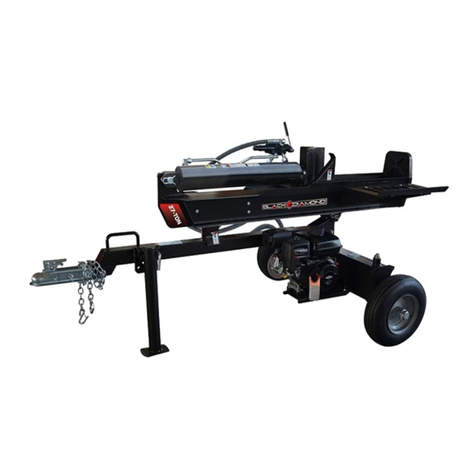
Black Diamond Equipment
Black Diamond Equipment BDKL27T User manual
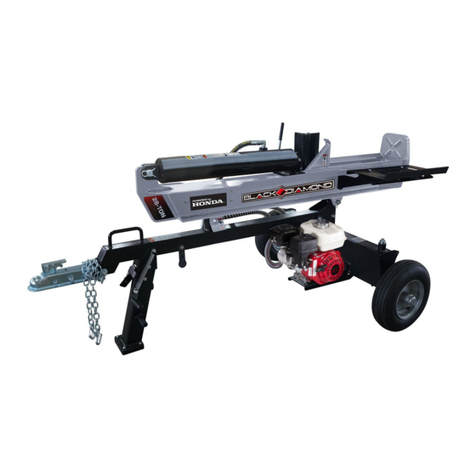
Black Diamond Equipment
Black Diamond Equipment BDH28T User manual
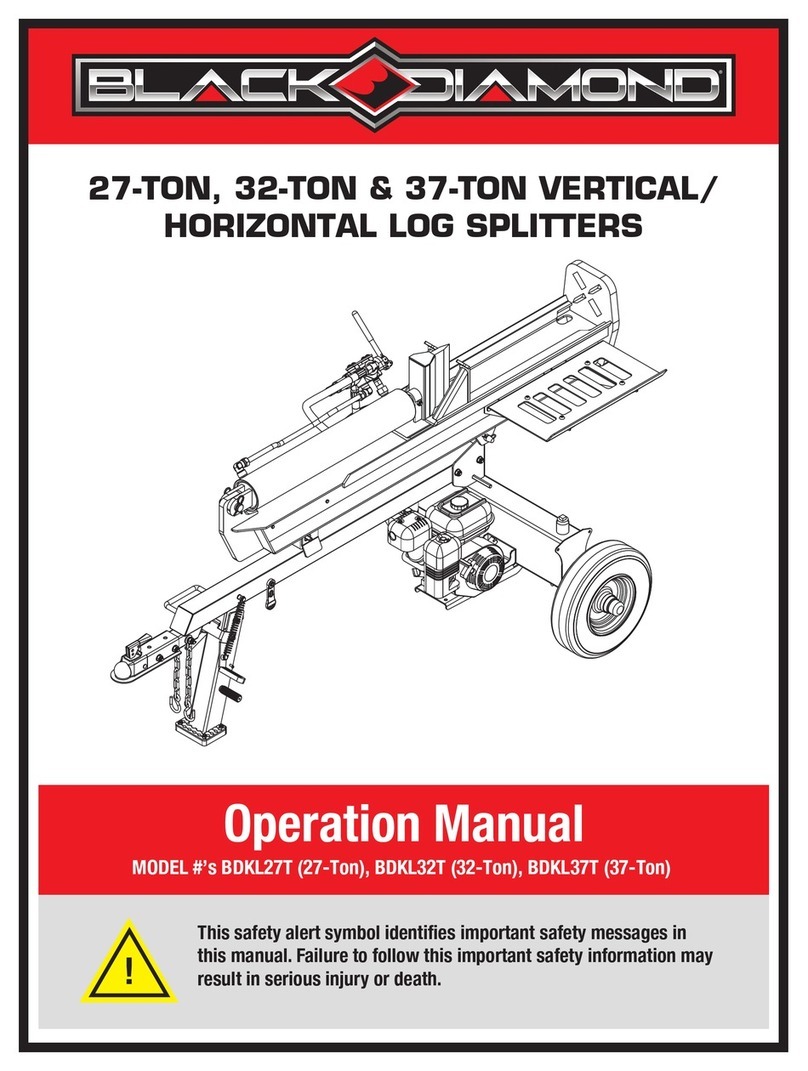
Black Diamond Equipment
Black Diamond Equipment BDKL37T User manual

Black Diamond Equipment
Black Diamond Equipment BD201257 User manual
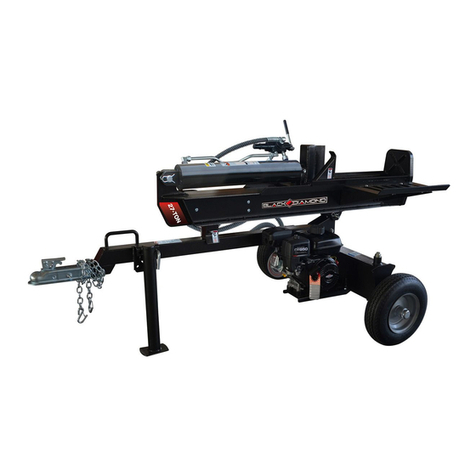
Black Diamond Equipment
Black Diamond Equipment BDBS27T User manual
